Assessing the Cooling Effect of Four Urban Parks of Different Sizes in a Temperate Continental Climate Zone: Wroclaw (Poland)
Abstract
:1. Introduction
2. Study Area
3. Data and Methods
3.1. Data Sources
- 28 May 2017, 9:43 GMT, 27.4 °C,
- 3 August 2018, at 9:43 GMT, 32.8 °C,
- 3 June 2019, 9:44 GMT, 28.9 °C.
3.2. Image Pre-Processing and Retrieval of LST
- calculating the Top of Atmospheric Spectral Radiance,
- conversion of the Radiance to Sensor Temperature,
- calculating the NDVI,
- calculating the Land Surface Emissivity, and
- LST retrieval.
3.3. Urban Park Metrics
- Park perimeter (PP),
- Park area (PA),
- Landscape shape index (LSI), which was designed by Patton (1975) and describes the compactness of a patch shape [37], in our case compactness of a park shape (7),
- 4.
- Park land cover (PLC) is the structure of a park’s land cover types expressed as a percentage of the total park area.
3.4. Spatial Statistics
- 3.
- 4.
- 5.
- Extended Park Cooling Island (PCIe), which we propose as the difference between the mean LST in the buffer of maximum cooling area (TR) and the mean LST inside the park (TP) (10):
4. Results
4.1. Analysis of Urban Park Metrics
4.2. Spatial Statistics of the Urban Park Effect on LST
4.2.1. A Park
4.2.2. B Park
4.2.3. C Park
4.2.4. D Park
5. Discussion
6. Conclusions
Author Contributions
Funding
Institutional Review Board Statement
Informed Consent Statement
Data Availability Statement
Conflicts of Interest
Appendix A
| Authors (Year of Publication) | Study Type | Source Data | Main Methods | Region, Climate |
|---|---|---|---|---|
| Jansson et al. (2007) [38] | (1, 2) | Ground based measurements | Temperature difference between the built-up area and the urban park, descriptive statistics | Stockholm (Sweden)/Continental |
| Cao et al. (2010) [37] | (1, 3) | Aster and Ikonos | Vegetation and shape indexes | Nagoya (Japan)/ Temperate humid |
| Hamada and Ohta (2010) [42] | (1) | Ground based measurements | Descriptive statistics, bivariate correlation | Nagoya (Japan)/ Temperate humid |
| Oliveira et al. (2011) [39] | (2) | Ground based measurements | Park cooling intensity (maximum difference between the measured values inside and outside of green area), distance index, influence of the solar exposure | Lisbon (Portugal)/Mediterranean |
| Mahmoud (2011) [51] | (2, 4) | Ground based measurements, Questionnaire surveys | Thermal comfort indices, regression analysis, descriptive statistics | Cairo (Egypt) /Desert |
| Cohen et al. (2012) [52] | (4) | Ground based measurements | Physiological Equivalent Temperature, regression analysis, human thermal comfort | Tel Aviv (Israel)/Subtropical Mediterranean |
| Choi et al. (2012) [43] | (1) | Landsat 7 | Kriging, spatial-autocorrelation, inverse distance squared weighting analysis | Seoul (Korea)/Humid continental |
| Siti Nor Afzan Buyadi et al. (2013) [29] | (4) | Landsat 5 | LST transect profiles, Temperature distribution of land use types | Shah Alam, Selangor (Malaysia)/Tropical |
| Ren et al. (2013) [47] | (3) | Landsat 5, SPOT | Descriptive statistics, correlation of Park Cooling Intensity and forest structure | Changchun, Jilin province (China)/Humid continental with monsoon influence |
| Kong et al. (2014) [46] | (1, 3) | Landsat 5, Ikonos | Multiple linear regression analysis of vegetation influence on PCI intensity | Nanjing, Jiangsu Province (China)/Subtropical |
| Chang and Li (2014) [62] | (4) | Ground based measurements | Classification and Regression Tree analysis, regression analysis | Taipei (Taiwan)/Subtropical monsoon |
| Feyisa et al. (2014) [60] | (1) | Landsat 7, ground based measurements | Park cooling distance, and intensity, regression | Addis Ababa (Ethiopia)/Desert |
| Skoulika et al. (2014) [11] | (1) | Ground based measurements | Nocturnal and daytime cool island intensity | Athens (Greece)/ Mediterranean |
| Anjos and Lopes (2014) [61] | (4) | Ground based measurements | Cluster analysis | Aracaju (Brasil)/ Tropical/subtropical |
| Doick et al. (2014) [44] | (1, 2) | Ground based measurements | Descriptive statistics, distance-temperature ratio, frequency distribution | London (UK)/Temperate oceanic |
| Cheng et al. (2015) [41] | (1) | Landsat | Correlation of LST and park size | Shanghai, China /Subtropical monsoon |
| Chen et al. (2015) [56] | (4) | Ground based measurements, Questionnaire surveys | Descriptive statistics, linear regression | Shanghai, China /Subtropical monsoon |
| Monteiro et al. (2016) [55] | (1, 4) | Ground based measurements | Size metric, regression analysis | London (UK)/Temperate oceanic |
| Bao et al. (2016) [48] | (1) | Landsat 5, 8 | Landscape metrics, park cooling distance and direction | Baotou, Inner Mongolia Province (China)/Continental |
| Yang et al. (2016) [10] | (1) | Ground based measurements | Diurnal UHI index, frequency distribution of UHI index differences | Beijing (China)/Humid continental |
| Anguluri and Narayanan (2017) [57] | (4) | Geo-eye | Per capita and proportional green indexes, GIS | Kalaburagi, North Karnataka (India)/ Tropical/subtropical |
| Du et al. (2017) [59] | (1, 3) | Landsat 8, Google Earth | Green cool indexes: range, amplitude of temperature drop, temperature gradient | Shanghai (China) Subtropical |
| Park et al. (2017) [45] | (2, 4) | Ground based measurements | Descriptive statistics/ linear regression analysis | Seoul (Korea)/Humid continental climate |
| Sun et al. (2017) [30] | (4) | Ground based measurements | Relationship between landscape parameters and thermal comfort, Numerical simulation modelling, bivariate regression | Beijing (China)/Humid continental |
| Xu et al. (2017) [49] | (4) | Landsat 5 QuickBird | Landscape structure index, woodland aggregation index, regression analysis | Beijing (China)/Humid continental |
| Yang et al. (2017) [12] | (3) | Landsat 8, | Area, perimeter, area to perimeter ratio, shape, total area and number of patches metrics | Changchun, Jilin Province (China)/Continental |
| Yang et al. (2017) [13] | (1, 4) | Landsat 8, GF-2 | Urban park metrics (area, perimeter, shape, patch density), cooling effect extent | Changchun/Changchun, Jilin Province (China)/Continental |
| Yu et al. (2017) [50] | (4) | Landsat 7, 8, SPOT 5, | PCI extent, intensity, efficiency, and TVoE | Fuzhou, Fujian Province (China)/Subtropical |
| Yu et al. (2018) [28] | (4) | Landsat 7, 8, SPOT 5, Google Earth | Land cover change effect on LST distribution | Fuzhou, Fujian Province (China)/Subtropical |
| Wang et al. (2018) [54] | (1, 4) | Landsat 8 | Temperature Drop Amplitude, Temperature Drop Range, Pearson correlation, regression analysis | Changzhou, Jiangsu Province (China)/Subtropical |
| Algretawee et al. (2019) [5] | (2) | Ground measurements (handheld devices) | Park cooling magnitude and distance indexes | Melbourne (Australia)/temperate oceanic |
| Li et al. (2020) [65] | (1, 2, 3) | Landsat 8 | Landscape metrics | Zhengzhou (China)/Humid subtropical |
| Peng et al. (2020) [40] | (1, 3) | Landsat 8 | Four park cooling indexes: intensity, gradient, area and efficiency | Shenzen (China)/Subtropical |
| Qiu and Jia, (2020) [58] | (1) | Landsat 8 | PCI range, amplitude of temperature difference, temperature gradient, regression analysis | Beijing (China)/Humid continental |
Appendix B
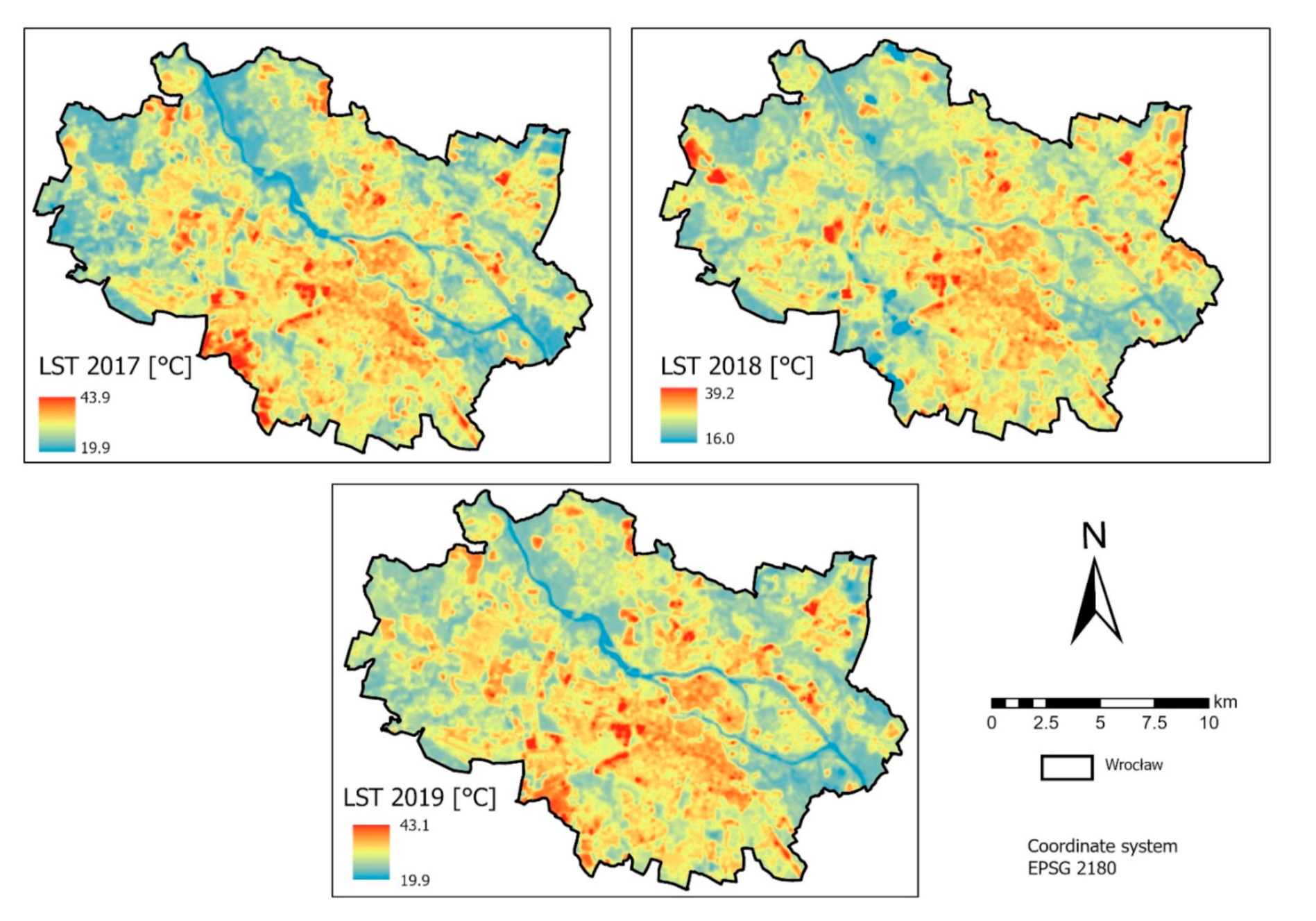
Appendix C

References
- Wittig, R.; Sukopp, H. Was ist Stadtökologie? Stadtökologie; Gustav Fischer Verlag: Stuttgart, Germany, 1993; pp. 1–9. (In German) [Google Scholar]
- Howard, L. The Climate of London, Deduced from Meteorological Observations, Made at Different Places in the Neighbourhood of the Metropolis, vol. 2, London; W. Phillips, George Yard, Lombard Street: London, UK, 1818; pp. 1818–1820. [Google Scholar]
- Oke, T. Street design and urban canopy layer climate. Energy Build. 1988, 11, 103–113. [Google Scholar] [CrossRef]
- Oke, T.R. The energetic basis of the urban heat island. Q. J. R. Meteorol. Soc. 1982, 108, 1–24. [Google Scholar] [CrossRef]
- Algretawee, H.; Rayburg, S.; Neave, M. Estimating the effect of park proximity to the central of Melbourne city on Urban Heat Island (UHI) relative to Land Surface Temperature (LST). Ecol. Eng. 2019, 138, 374–390. [Google Scholar] [CrossRef]
- Salleh, S.A.; Latif, Z.A.; Mohd, W.M.N.W.; Chan, A. Factors Contributing to the Formation of an Urban Heat Island in Putrajaya, Malaysia. Procedia-Soc. Behav. Sci. 2013, 105, 840–850. [Google Scholar] [CrossRef] [Green Version]
- Wickham, C.; Rohde, R.; Muller, R.A.; Wurtele, J.; Curry, J.; Groom, D.; Jacobsen, R.; Perlmutter, S.; Rosenfeld, A.; Mosher, S. Influence of Urban Heating on the Global Temperature Land Average using Rural Sites Indentifed from MODIS Classifications. Geoinformat. Geostat. 2013. [Google Scholar] [CrossRef]
- Dixon, P.G.; Mote, T.L. Patterns and Causes of Atlanta’s Urban Heat Island–Initiated Precipitation. J. Appl. Meteorol. Climatol. 2003, 42, 1273–1284. [Google Scholar] [CrossRef]
- Singh, P.; Kikon, N.; Verma, P. Impact of land use change and urbanization on urban heat island in Lucknow city, Central India. A remote sensing based estimate. Sustain. Cities Soc. 2017, 32, 100–114. [Google Scholar] [CrossRef]
- Yang, P.; Xiao, Z.-N.; Ye, M.-S. Cooling effect of urban parks and their relationship with urban heat islands. Atmos. Ocean. Sci. Lett. 2016, 9, 298–305. [Google Scholar] [CrossRef] [Green Version]
- Skoulika, F.; Santamouris, M.; Kolokotsa, D.; Boemi, S.-N. On the thermal characteristics and the mitigation potential of a medium size urban park in Athens, Greece. Landsc. Urban Plan. 2014, 123, 73–86. [Google Scholar] [CrossRef]
- Yang, C.; He, X.; Wang, R.; Yan, F.; Yu, L.; Bu, K.; Yang, J.; Chang, L.; Zhang, S. The Effect of Urban Green Spaces on the Urban Thermal Environment and Its Seasonal Variations. Forests 2017, 8, 153. [Google Scholar] [CrossRef] [Green Version]
- Yang, C.; He, X.; Yu, L.; Yang, J.; Yan, F.; Bu, K.; Chang, L.; Zhang, S. The Cooling Effect of Urban Parks and Its Monthly Variations in a Snow Climate City. Remote Sens. 2017, 9, 1066. [Google Scholar] [CrossRef] [Green Version]
- Unger, J. Intra-urban relationship between surface geometry and urban heat island: Review and new approach. Clim. Res. 2004, 27, 253–264. [Google Scholar] [CrossRef] [Green Version]
- Padhy, S.K.; Sarkar, S.; Panigrahi, M.; Paul, S. Mental health effects of climate change. Indian J. Occup. Environ. Med. 2015, 19, 3–7. [Google Scholar] [CrossRef] [PubMed] [Green Version]
- Yang, T.C.; Jensen, L. Climatic conditions and human mortality: Spatial and regional variation in the United States. Popul. Environ. 2017, 38, 261–285. [Google Scholar] [CrossRef] [PubMed]
- Chiabai, A.; Quiroga, S.; Martinez-Juarez, P.; Higgins, S.; Taylor, T. The nexus between climate change, ecosystem services and human health: Towards a conceptual framework. Sci. Total Environ. 2018, 635, 1191–1204. [Google Scholar] [CrossRef] [PubMed]
- Lou, J.; Wu, Y.; Liu, P.; Kota, S.H.; Huang, L. Health Effects of Climate Change Through Temperature and Air Pollution. Curr. Pollut. Rep. 2019, 5, 144–158. [Google Scholar] [CrossRef]
- Benz, S.A.; Bayer, P.; Goettsche, F.-M.; Olesen, F.S.; Blum, P. Linking Surface Urban Heat Islands with Groundwater Temperatures. Environ. Sci. Technol. 2015, 50, 70–78. [Google Scholar] [CrossRef]
- Zhu, K.; Bayer, P.; Grathwohl, P.; Blum, P. Groundwater temperature evolution in the subsurface urban heat island of Co-logne, Germany. Hydrol. Process. 2015, 29, 965–978. [Google Scholar] [CrossRef]
- Jiang, J.; Tian, G. Analysis of the impact of Land use/Land cover change on Land Surface Temperature with Remote Sensing. Procedia Environ. Sci. 2010, 2, 571–575. [Google Scholar] [CrossRef] [Green Version]
- Xiao, R.-B.; Ouyang, Z.-Y.; Zheng, H.; Li, W.-F.; Schienke, E.W.; Wang, X.-K. Spatial pattern of impervious surfaces and their impacts on land surface temperature in Beijing, China. J. Environ. Sci. 2007, 19, 250–256. [Google Scholar] [CrossRef]
- Howe, D.; Hathaway, J.; Ellis, K.; Mason, L. Spatial and temporal variability of air temperature across urban neighborhoods with varying amounts of tree canopy. Urban For. Urban Green. 2017, 27, 109–116. [Google Scholar] [CrossRef]
- U.S. Environmental Protection Agency. Reducing Urban Heat Islands: Compendium of Strategies. Draft. Available online: https://www.epa.gov/heat-islands/heat-island-compendium (accessed on 26 March 2021).
- Aram, F.; Garcia, E.H.; Solgi, E.; Mansournia, S. Urban green space cooling effect in cities. Heliyon 2019, 5, e01339. [Google Scholar] [CrossRef] [PubMed] [Green Version]
- Oke, T.R.; Crowther, J.M.; McNaughton, K.G.; Monteith, J.L.; Gardiner, B. The micrometeorology of the urban forest. Philos. Trans. R. Soc. Lond. B Biol. Sci. 1989, 324, 335–349. [Google Scholar] [CrossRef]
- Declet-Barreto, J.; Brazel, A.J.; Martin, C.A.; Chow, W.; Harlan, S.L. Creating the park cool island in an inner-city neighborhood: Heat mitigation strategy for Phoenix, AZ. Urban Ecosyst. 2013, 16, 617–635. [Google Scholar] [CrossRef]
- Yu, Z.; Guo, X.; Zeng, Y.; Koga, M.; Vejre, H. Variations in land surface temperature and cooling efficiency of green space in rapid urbanization: The case of Fuzhou city, China. Urban For. Urban Green. 2018, 29, 113–121. [Google Scholar] [CrossRef]
- Buyadi, S.N.A.; Mohd, W.M.N.W.; Misni, A. Impact of Land Use Changes on the Surface Temperature Distribution of Area Surrounding the National Botanic Garden, Shah Alam. Procedia-Soc. Behav. Sci. 2013, 101, 516–525. [Google Scholar] [CrossRef] [Green Version]
- Sun, S.; Xu, X.; Lao, Z.; Liu, W.; Li, Z.; Garcia, E.H.; He, L.; Zhu, J. Evaluating the impact of urban green space and landscape design parameters on thermal comfort in hot summer by numerical simulation. Build. Environ. 2017, 123, 277–288. [Google Scholar] [CrossRef]
- Sun, Q.; Wu, Z.; Tan, J. The relationship between land surface temperature and land use/land cover in Guangzhou, China. Environ. Earth Sci. 2012, 65, 1687–1694. [Google Scholar] [CrossRef]
- Sun, Q.; Tan, J.; Xu, Y. An ERDAS image processing method for retrieving LST and describing urban heat evolution: A case study in the Pearl River Delta Region in South China. Environ. Earth Sci. 2009, 59, 1047–1055. [Google Scholar] [CrossRef]
- Arulbalaji, P.; Padmalal, D.; Maya, K. Impact of urbanization and land surface temperature changes in a coastal town in Kerala, India. Environ. Earth Sci. 2020, 79, 1–18. [Google Scholar] [CrossRef]
- Jauregui, E. Influence of a large urban park on temperature and convective precipitation in a tropical city. Energy Build. 1990, 15, 457–463. [Google Scholar] [CrossRef]
- Spronken-Smith, R.A.; Oke, T.R.; Lowry, W.P. Advection and the surface energy balance across an irrigated urban park. Int. J. Climatol. 2000, 20, 1033–1047. [Google Scholar] [CrossRef]
- Liu, G.; Zhang, Q.; Li, G.; Doronzo, D.M. Response of land cover types to land surface temperature derived from Landsat-5 TM in Nanjing Metropolitan Region, China. Environ. Earth Sci. 2016, 75, 1386. [Google Scholar] [CrossRef]
- Cao, X.; Onishi, A.; Chen, J.; Imura, H. Quantifying the cool island intensity of urban parks using ASTER and IKONOS data. Landsc. Urban Plan. 2010, 96, 224–231. [Google Scholar] [CrossRef]
- Jansson, C.; Jansson, P.-E.; Gustafsson, D. Near surface climate in an urban vegetated park and its surroundings. Theor. Appl. Clim. 2007, 89, 185–193. [Google Scholar] [CrossRef]
- Oliveira, S.; Andrade, H.; Vaz, T. The cooling effect of green spaces as a contribution to the mitigation of urban heat: A case study in Lisbon. Build. Environ. 2011, 46, 2186–2194. [Google Scholar] [CrossRef]
- Peng, J.; Dan, Y.; Qiao, R.; Liu, Y.; Dong, J.; Wu, J. How to quantify the cooling effect of urban parks? Linking maximum and accumulation perspectives. Remote Sens. Environ. 2021, 252, 112135. [Google Scholar] [CrossRef]
- Cheng, X.; Wei, B.; Chen, G.; Li, J.; Song, C. Influence of Park Size and Its Surrounding Urban Landscape Patterns on the Park Cooling Effect. J. Urban Plan. Dev. 2015, 141, 4014002. [Google Scholar] [CrossRef]
- Hamada, S.; Ohta, T. Seasonal variations in the cooling effect of urban green areas on surrounding urban areas. Urban For. Urban Green. 2010, 9, 15–24. [Google Scholar] [CrossRef]
- Choi, H.-A.; Lee, W.-K.; Byun, W.-H. Determining the Effect of Green Spaces on Urban Heat Distribution Using Satellite Imagery. Asian J. Atmos. Environ. 2012, 6, 127–135. [Google Scholar] [CrossRef]
- Doick, K.J.; Peace, A.; Hutchings, T.R. The role of one large greenspace in mitigating London’s nocturnal urban heat island. Sci. Total Environ. 2014, 493, 662–671. [Google Scholar] [CrossRef] [PubMed]
- Park, J.; Kim, J.-H.; Lee, D.K.; Park, C.Y.; Jeong, S.G. The influence of small green space type and structure at the street level on urban heat island mitigation. Urban For. Urban Green. 2017, 21, 203–212. [Google Scholar] [CrossRef]
- Kong, F.; Yin, H.; Wang, C.; Cavan, G.; James, P. A satellite image-based analysis of factors contributing to the green-space cool island intensity on a city scale. Urban For. Urban Green. 2014, 13, 846–853. [Google Scholar] [CrossRef] [Green Version]
- Ren, Z.; He, X.; Zheng, H.; Zhang, D.; Yu, X.; Shen, G.; Guo, R. Estimation of the relationship between urban park characteristics and park cool island intensity by remote sensing data and field measurement. Forests 2013, 4, 868–886. [Google Scholar] [CrossRef] [Green Version]
- Bao, T.; Li, X.; Zhang, J.; Zhang, Y.; Tian, S. Assessing the Distribution of Urban Green Spaces and its Anisotropic Cooling Distance on Urban Heat Island Pattern in Baotou, China. ISPRS Int. J. Geo-Inf. 2016, 5, 12. [Google Scholar] [CrossRef]
- Xu, X.; Cai, H.; Qiao, Z.; Wang, L.; Jin, C.; Ge, Y.; Wang, L.; Xu, F. Impacts of park landscape structure on thermal environment using QuickBird and Landsat images. Chin. Geogr. Sci. 2017, 27, 818–826. [Google Scholar] [CrossRef]
- Yu, Z.; Guo, X.; Jørgensen, G.; Vejre, H. How can urban green spaces be planned for climate adaptation in subtropical cities? Ecol. Indic. 2017, 82, 152–162. [Google Scholar] [CrossRef]
- Mahmoud, A.H.A. Analysis of the microclimatic and human comfort conditions in an urban parkin hot and arid regions. Build. Environ. 2011, 46, 2641–2656. [Google Scholar] [CrossRef]
- Cohen, P.; Potchter, O.; Matzarakis, A. Daily and seasonal climatic conditions of green urban open spaces in the Mediterranean climate and their impact on human comfort. Build. Environ. 2012, 51, 285–295. [Google Scholar] [CrossRef]
- Wang, X.; Cheng, H.; Xi, J.; Yang, G.; Zhao, Y. Relationship between Park Composition, Vegetation Characteristics and Cool Island Effect. Sustainability 2018, 10, 587. [Google Scholar] [CrossRef] [Green Version]
- Wang, G.; Tian, G.; Jombach, S.; Li, H. Mapping and Analyzing the Park Cooling Effect on Urban Heat Island in an Expanding City: A Case Study in Zhengzhou City, China. Land 2020, 9, 57. [Google Scholar] [CrossRef] [Green Version]
- Monteiro, M.V.; Doick, K.J.; Handley, P.; Peace, A. The impact of greenspace size on the extent of local nocturnal air temperature cooling in London. Urban For. Urban Green. 2016, 16, 160–169. [Google Scholar] [CrossRef]
- Chen, L.; Wen, Y.; Zhang, L.; Xiang, W.-N. Studies of thermal comfort and space use in an urban park square in cool and cold seasons in Shanghai. Build. Environ. 2015, 94, 644–653. [Google Scholar] [CrossRef]
- Anguluri, R.; Narayanan, P. Role of green space in urban planning: Outlook towards smart cities. Urban For. Urban Green. 2017, 25, 58–65. [Google Scholar] [CrossRef]
- Qiu, K.; Jia, B. The roles of landscape both inside the park and the surroundings in park cooling effect. Sustain. Cities Soc. 2020, 52, 101864. [Google Scholar] [CrossRef]
- Du, H.; Cai, W.; Xu, Y.; Wang, Z.; Wang, Y.; Cai, Y. Quantifying the cool island effects of urban green spaces using remote sensing Data. Urban For. Urban Green. 2017, 27, 24–31. [Google Scholar] [CrossRef]
- Feyisa, G.L.; Dons, K.; Meilby, H. Efficiency of parks in mitigating urban heat island effect: An example from Addis Ababa. Landsc. Urban Plan. 2014, 123, 87–95. [Google Scholar] [CrossRef]
- Anjos, M.; Lopes, A. Urban Heat Island and Park Cool Island Intensities in the Coastal City of Aracaju, North-Eastern Brazil. Sustainability 2017, 9, 1379. [Google Scholar] [CrossRef] [Green Version]
- Chang, C.-R.; Li, M.-H. Effects of urban parks on the local urban thermal environment. Urban For. Urban Green. 2014, 13, 672–681. [Google Scholar] [CrossRef]
- Honjo, T.; Takakura, T. Analysis of Temperature Distribution of Urban Green Spaces Using Remote Sensing Data. J. Jpn. Inst. Landsc. Arch. 1985, 49, 299–304. [Google Scholar] [CrossRef] [Green Version]
- Hamada, T.; Mikami, T. Cool Island Phenomenon in Urban Green Spaces: A Case Study of Meiji Shrine and Yoyogi Park. Geogr. Rev. Jpn. 1994, 67, 518–529. [Google Scholar] [CrossRef] [Green Version]
- Voogt, J.A.; Oke, T.R. Thermal remote sensing of urban climates. Remote Sens. Environ. 2003, 86, 370–384. [Google Scholar] [CrossRef]
- Statistical Office in Wroclaw. Statistics Poland. Available online: http://demografia.stat.gov.pl/bazademografia/Tables.aspx (accessed on 3 October 2020). (In Polish)
- Report on the State of the City 2019, Wroclaw City Council. Available online: https://bip.um.wroc.pl/attachments/download/85122 (accessed on 3 October 2020). (In Polish).
- Szymanowski, M.; Kryza, M. Application of Remotely Sensed Data for Spatial Approximation of Urban Heat Island in the City of Wrocław, Poland. In JURSE 2011—Joint Urban Remote Sensing Event; Stilla, U., Gamba, P., Juergens, C., Maktav, D., Eds.; IEEE: Munich, Germany, 2011; pp. 353–356. [Google Scholar] [CrossRef]
- Kwiatkowski, J. The range of Sudetes phenomena and their influence on the mesoclimate of the south-western and central regions of Poland. Pol. Geogr. Rev. Pol. 1975, 20, 1. [Google Scholar]
- Sikora, S. Bioclimate of Wroclaw; Institute of Geography and Regional Development, University of Wroclaw: Wrocław, Poland, 2008; ISBN 978-83-9281193-2-5. [Google Scholar]
- Dubicki, A.; Dubicka, M.; Szymanowski, M. Climate of Wroclaw, Environment. 2002. Available online: http://eko.org.pl/wroclaw/srodowisko/klimat.html (accessed on 3 October 2020). (In Polish).
- Dąbek, P.B.; Jurasz, J. GIS estimated potential of rooftop PVs in urban areas—Case study Wrocław (Poland). E3S Web Conf. 2018, 45, 14. [Google Scholar] [CrossRef] [Green Version]
- Ogimet Weather Service. Available online: http://ogimet.com/cgi-bin/gsynres?ind=12424&lang=en&decoded=yes&ndays=2&ano=2018&mes=07&day=19&hora=12 (accessed on 2 March 2021).
- Szymanowski, M.; Kryza, M. Local regression models for spatial interpolation of urban heat island—An example from Wrocław, SW Poland. Theor. Appl. Clim. 2011, 108, 53–71. [Google Scholar] [CrossRef] [Green Version]
- Szymanowski, M. Spatial structure of the urban heat island in Wroclaw, Poland. In Proceedings of the 5th International Con-ference on Urban Climate, Lodz, Poland, 1–5 September 2003; Available online: http://meteo.geo.uni.lodz.pl/icuc5 (accessed on 15 January 2021).
- Wroclaw City Council. Study of the Conditions and Directions of Spatial Development in Wrocław; Wroclaw City Council: Wroclaw, Poland, 2018. (In Polish) [Google Scholar]
- CORINE Land Cover. Copernicus Land Monitoring Service; CORINE Land Cover: Copenhagen, Denmark, 2021; Available online: https://land.copernicus.eu/pan-european/corine-land-cover (accessed on 3 May 2021).
- Head Office of Geodesy and Cartography. National Geodetic and Cartographic Resources. Available online: https://www.geoportal.gov.pl/dane (accessed on 14 December 2020).
- Wroclaw Spatial Information System. Available online: https://geoportal.wroclaw.pl/en/resources/ (accessed on 15 December 2020).
- United States Geological Survey. Available online: https://www.usgs.gov/core-science-systems/nli/landsat/using-usgs-landsat-level-1-data-product (accessed on 10 March 2021).
- ESRI. Available online: https://www.esri.com/en-us/arcgis/products/arcgis-pro/overview (accessed on 11 December 2020).
- Jin, M.; Li, J.; Wang, C.; Shang, R. A Practical Split-Window Algorithm for Retrieving Land Surface Temperature from Landsat-8 Data and a Case Study of an Urban Area in China. Remote Sens. 2015, 7, 4371–4390. [Google Scholar] [CrossRef] [Green Version]
- Du, C.; Ren, H.; Qin, Q.; Meng, J.; Zhao, S. A Practical Split-Window Algorithm for Estimating Land Surface Temperature from Landsat 8 Data. Remote Sens. 2015, 7, 647–665. [Google Scholar] [CrossRef] [Green Version]
- Avdan, U.; Jovanovska, G. Algorithm for Automated Mapping of Land Surface Temperature Using LANDSAT 8 Satellite Data. J. Sens. 2016, 2016, 1480307. [Google Scholar] [CrossRef] [Green Version]
- Liu, S.; Su, H.; Zhang, R.; Tian, J.; Wang, W. Estimating the Surface Air Temperature by Remote Sensing in Northwest China Using an Improved Advection-Energy Balance for Air Temperature Model. Adv. Meteorol. 2016, 2016, 1–11. [Google Scholar] [CrossRef] [Green Version]
- Wang, C.; Wang, Z.-H.; Wang, C.; Myint, S.W. Environmental cooling provided by urban trees under extreme heat and cold waves in U.S. cities. Remote Sens. Environ. 2019, 227, 28–43. [Google Scholar] [CrossRef]
- Suchecka, J. Spatial statistics. Methods of analyzing spatial structures. Procedia Soc. Behav. Sci. 2014, 21, 43–52. (In Polish) [Google Scholar]
- Cai, Z.; Han, G.; Chen, M. Do water bodies play an important role in the relationship between urban form and land surface temperature? Sustain. Cities Soc. 2018, 39, 487–498. [Google Scholar] [CrossRef]
- Leitao, A.B.; Miller, J.; Ahern, J.; McGarigal, K. Measuring Landscapes: A Planner’s Hand-Book; Island Press: Washington, DC, USA, 2012; ISBN 978-1-59726-772-4. [Google Scholar]
- Schwarz, N.; Schlink, U.; Franck, U.; Großmann, K. Relationship of land surface and air temperatures and its implications for quantifying urban heat island indicators—An application for the city of Leipzig (Germany). Ecol. Indic. 2012, 18, 693–704. [Google Scholar] [CrossRef]

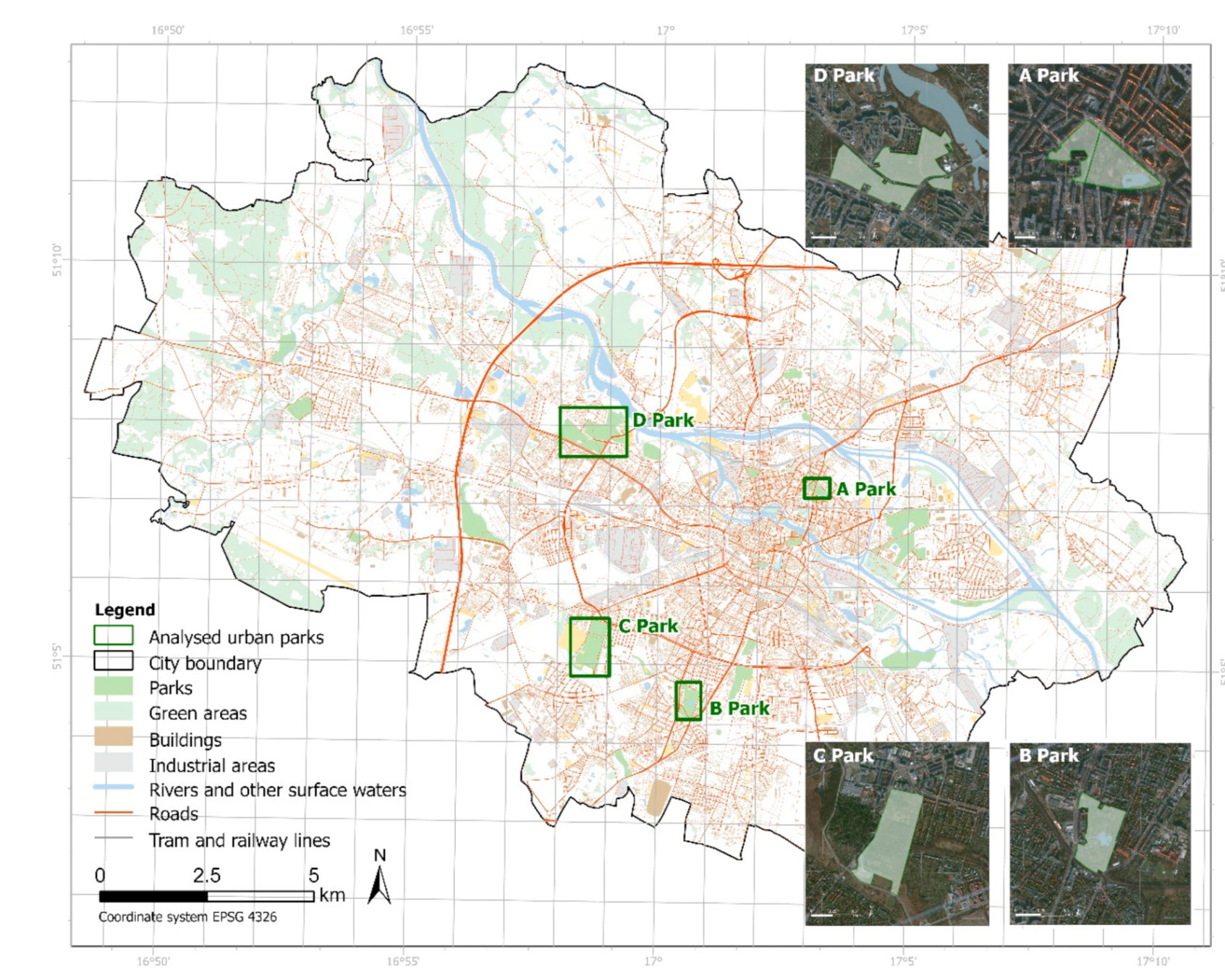
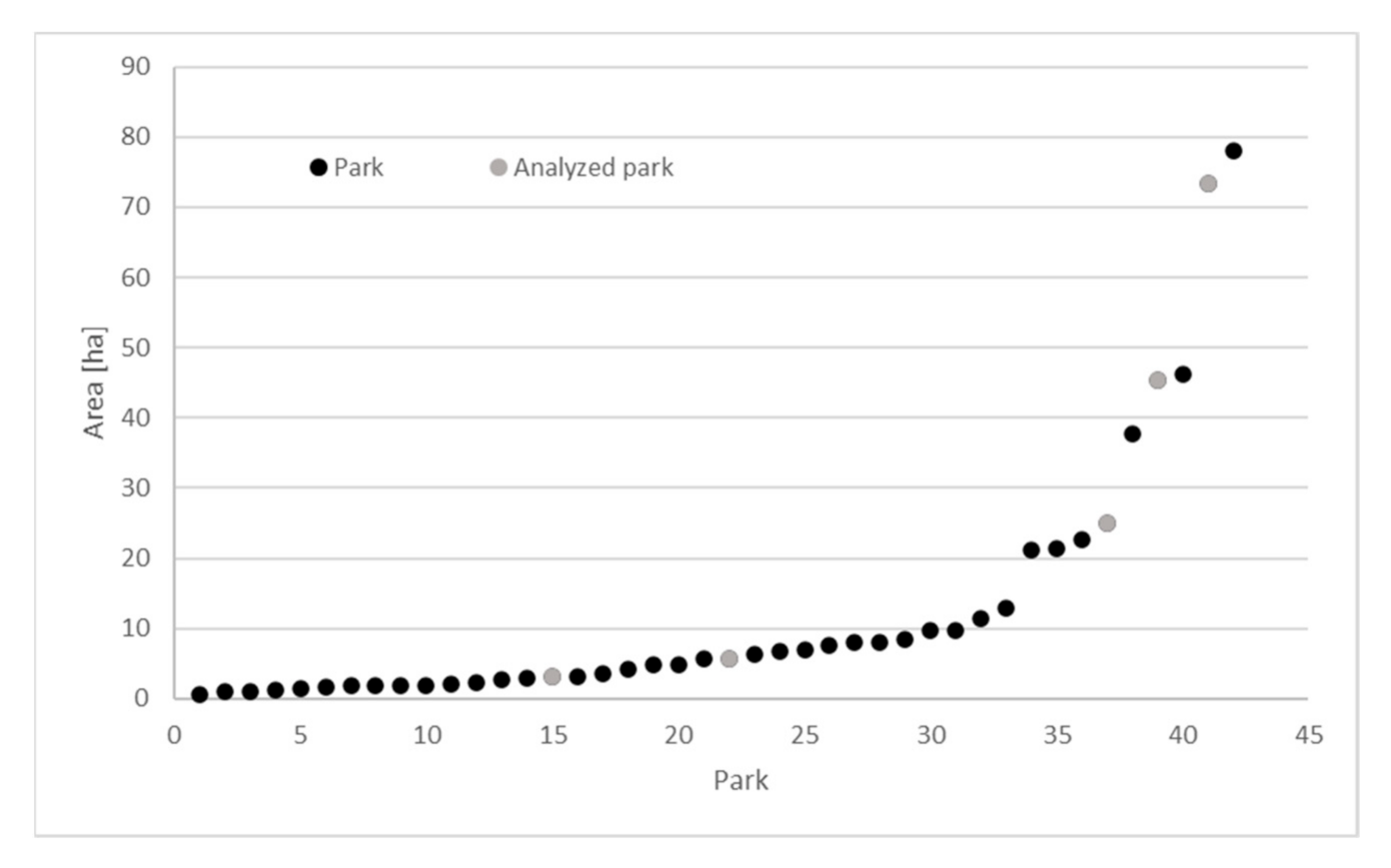

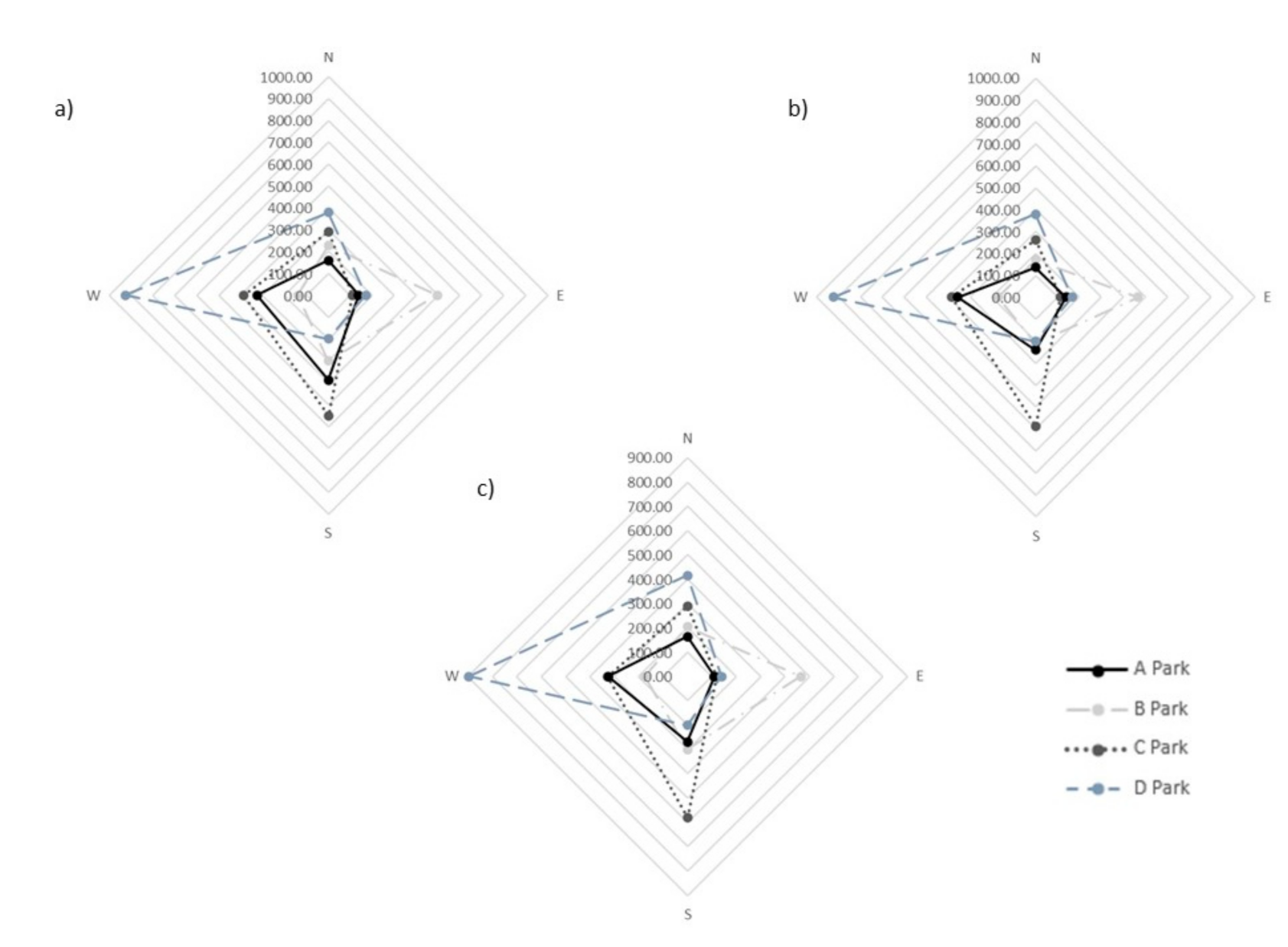
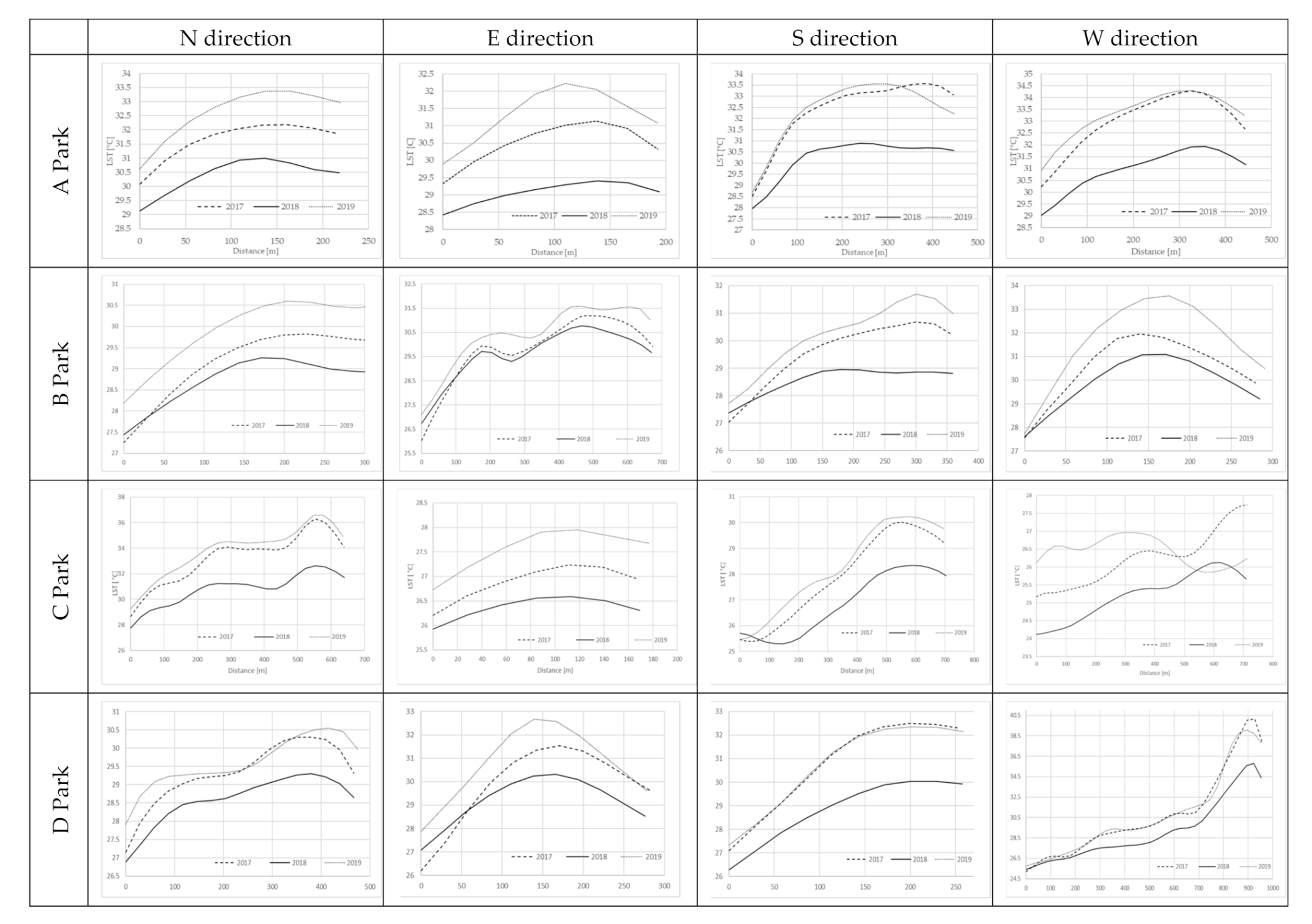
| Value/Year | 2017 | 2018 | 2019 |
|---|---|---|---|
| Min. | 19.9 °C | 16.0 °C | 19.9 °C |
| Max. | 43.9 °C | 39.2 °C | 43.1 °C |
| Mean | 28.3 °C | 27.6 °C | 28.6 °C |
| Park | Area (ha) | Perimeter (m) | LSI | PLC | Geometry (Not to Scale) |
|---|---|---|---|---|---|
| A Park | 8.84 | 1669 | 1.58 | F 7.8% G 71.4% W 7.6% O 13.2% |  |
| B Park | 27.57 | 2845 | 1.53 | F 63.6% G 19.5% W 5.3% O 11.6% |  |
| C Park | 45.23 | 3722 | 1.43 | F 73.2% G 19.3% W 0.0% O 7.5% | 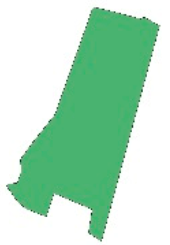 |
| D Park | 76.87 | 6310 | 2.61 | F 92.1% G 7.7% W 0.0% O 0.2% |  |
| Statistics | Park | 2017 | 2018 | 2019 |
|---|---|---|---|---|
| Mean LST [°C] | A Park | 28.2 | 27.7 | 28.8 |
| B Park | 25.8 | 26.7 | 26.9 | |
| C Park | 25.6 | 25.2 | 26.3 | |
| D Park | 25.7 | 25.9 | 26.4 | |
| PCA [ha] | A Park | 101.6 | 89.9 | 78.8 |
| B Park | 199.1 | 182.4 | 181.0 | |
| C Park | 287.9 | 312.8 | 308.3 | |
| D Park | 691.8 | 688.7 | 660.5 | |
| PCE | A Park | 11.5 | 10.2 | 8.9 |
| B Park | 7.2 | 6.6 | 6.6 | |
| C Park | 5.3 | 5.8 | 5.7 | |
| D Park | 9.4 | 9.4 | 9.0 | |
| PCG [°C/100 m] | A Park | 1.3 | 1.0 | 1.8 |
| B Park | 1.6 | 1.2 | 1.7 | |
| C Park | 1.0 | 0.7 | 1.0 | |
| D Park | 2.1 | 1.4 | 2.0 | |
| PCI [°C] | A Park | 3.1 | 1.9 | 2.8 |
| B Park | 3.6 | 2.1 | 3.0 | |
| C Park | 3.4 | 2.2 | 3.0 | |
| D Park | 2.9 | 2.0 | 2.2 | |
| PCIe [°C] | A Park | 3.1 | 2.0 | 3.0 |
| B Park | 3.6 | 2.1 | 3.1 | |
| C Park | 3.4 | 2.3 | 3.1 | |
| D Park | 3.1 | 2.1 | 2.3 |
Publisher’s Note: MDPI stays neutral with regard to jurisdictional claims in published maps and institutional affiliations. |
© 2021 by the authors. Licensee MDPI, Basel, Switzerland. This article is an open access article distributed under the terms and conditions of the Creative Commons Attribution (CC BY) license (https://creativecommons.org/licenses/by/4.0/).
Share and Cite
Blachowski, J.; Hajnrych, M. Assessing the Cooling Effect of Four Urban Parks of Different Sizes in a Temperate Continental Climate Zone: Wroclaw (Poland). Forests 2021, 12, 1136. https://doi.org/10.3390/f12081136
Blachowski J, Hajnrych M. Assessing the Cooling Effect of Four Urban Parks of Different Sizes in a Temperate Continental Climate Zone: Wroclaw (Poland). Forests. 2021; 12(8):1136. https://doi.org/10.3390/f12081136
Chicago/Turabian StyleBlachowski, Jan, and Monika Hajnrych. 2021. "Assessing the Cooling Effect of Four Urban Parks of Different Sizes in a Temperate Continental Climate Zone: Wroclaw (Poland)" Forests 12, no. 8: 1136. https://doi.org/10.3390/f12081136
APA StyleBlachowski, J., & Hajnrych, M. (2021). Assessing the Cooling Effect of Four Urban Parks of Different Sizes in a Temperate Continental Climate Zone: Wroclaw (Poland). Forests, 12(8), 1136. https://doi.org/10.3390/f12081136






